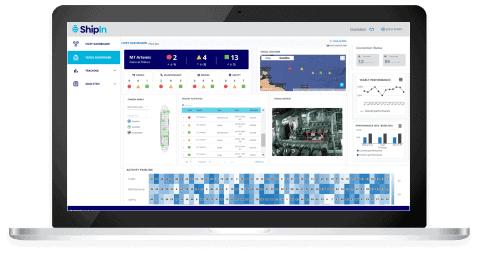Every day, thousands of ships leave port with millions of dollars in cargo and equipment onboard. But from the time a ship leaves port until it docks at another, the communication between ship and shore is often spotty and incomplete.
There are thousands of moving parts that make up a successful voyage, but the only communication available to most shipping companies is after-the-fact Captain’s reports over shaky satellite connections.
The questions remain:
- How smoothly did navigation go?
- Were scheduled repairs made on time?
- Were safety protocols followed?
- Did the cargo remain secure?
Unlocking Economic Benefits with Advanced Ship Insights
Helping shipping companies gain stronger insights into their fleets is exactly why we do what we do here at ShipIn. And it’s not just for peace of mind: A recent study estimated an economic benefit of $400,000 per vessel each year when using ShipIn’s FleetVision™ system.
We believe so strongly in the value of this innovation that we filed and received a U.S. Patent 11,132,552 Bl, or “System And Method For Bandwidth Reduction And Communication Of Visual Events,” for this cutting-edge technology we call FleetVision™. We’re pursuing answers to this pressing industry question in an effort to make shipping more efficient, safe, and profitable.
How ShipIn’s Technology Works
FleetVision™ uses visual information from ships to foster and improve the handling of cargo operations, maintenance, safety and security, and day-to-day activities. It works by pairing artificial intelligence (AI) with shipboard camera systems (CCTV) and analytics.
With ShipIn’s newly patented FleetVision™ System, the AI system recognizes and processes the information from the network of cameras, summarizing activities in designated high-priority areas of the ship, such as cargo holds, the bridge, and engine rooms.
AI-Powered Visual Insights for Enhanced Ship Operations
Unlike traditional closed-circuit camera-based solutions, ShipIn uses AI to watch and process this massive, continuously-streaming amount of data onboard the ship, prioritizing exactly what information requires action, such as:
- Real-time hazard detection
- Digital logging of routine events and maintenance
- Inter-fleet benchmarking
The AI system includes elements from the field of computer vision which allows computers to understand what they see. It also includes elements from machine learning and deep learning which allow computers to learn and improve their performance over time from the examples they encounter.
ShipIn’s FleetVision™ technology maximizes opportunities for efficient ship-to-shore communication over available satellite links, even when that coverage is spotty. In this way, ShipIn can provide nearly continuous communication and visibility from ship-to-shore into shipboard activities, shipboard behavior, and shipboard status so that a shore-based manager can review, comprehend, and synthesize such information at-a-glance:

Streamlining Ship and Shore Collaboration
This can be used to review daily operations or discuss recent events on the sailing commercial merchant vessel without the need to watch hours, days, or weeks of multiple channels of video. From there, ship owners, captains, and crew can take appropriate action steps to prevent further damage, initiate safety protocols, or receive updates as needed, facilitating operational efficiencies.
Why We Filed a Patent for This Technology
We’re combining some of the oldest technology known to humanity — the humble ship — with one of the most important inventions of the 21st century — artificial intelligence — to provide a better, brighter future for the shipping industry. This combination, we felt, was an innovation that merited patent protection.
Automating Incident Detection for Proactive Operations
Rather than requiring a crew member to actively monitor camera feeds or watch thousands of hours of data, ShipIn actively identifies key incidents and events and surfaces those findings to a dashboard available to onboard crew and shore operations for them to take action.
Enhancing Cargo, Safety, and Security Protocols
This includes:
- Improved efficiency in cargo operations: That same study surfaced inter-fleet best practices that allowed one shipping leader to bring all of its vessels up to the standards of their top performers, turning around cargo 1.5 hours faster per ship, yielding 3 extra days at sea every year, per vessel.
- Stronger safety protocols: More than 50% of machinery-related incidents were attributable, at least in part, to a lack of compliance with basic maintenance routines. Visibility into potential hazards and real-time incidents allow for a stronger culture of safety on board.
- Security and peace of mind: Acts of piracy, stowaways, and drug smuggling are difficult to control, but often affect a ship’s schedule and result in revenue losses to the shipowners. Identifying security issues before they happen — and having a clear record if they do — allow for peace of mind for crew and executives alike.
See How ShipIn Can Help Your Fleet
At ShipIn, we embrace innovation in order to solve pressing business challenges, and we hope that our patented technology will help your fleet become more innovative as well. ShipIn equips ship owners, operators, and seafarers with advanced digital tools for safer and more productive voyages, and enables unparalleled ship-shore collaboration, critical to delivering growth in today’s global market conditions. Learn more about how this innovative technology can help your shipping organization.


